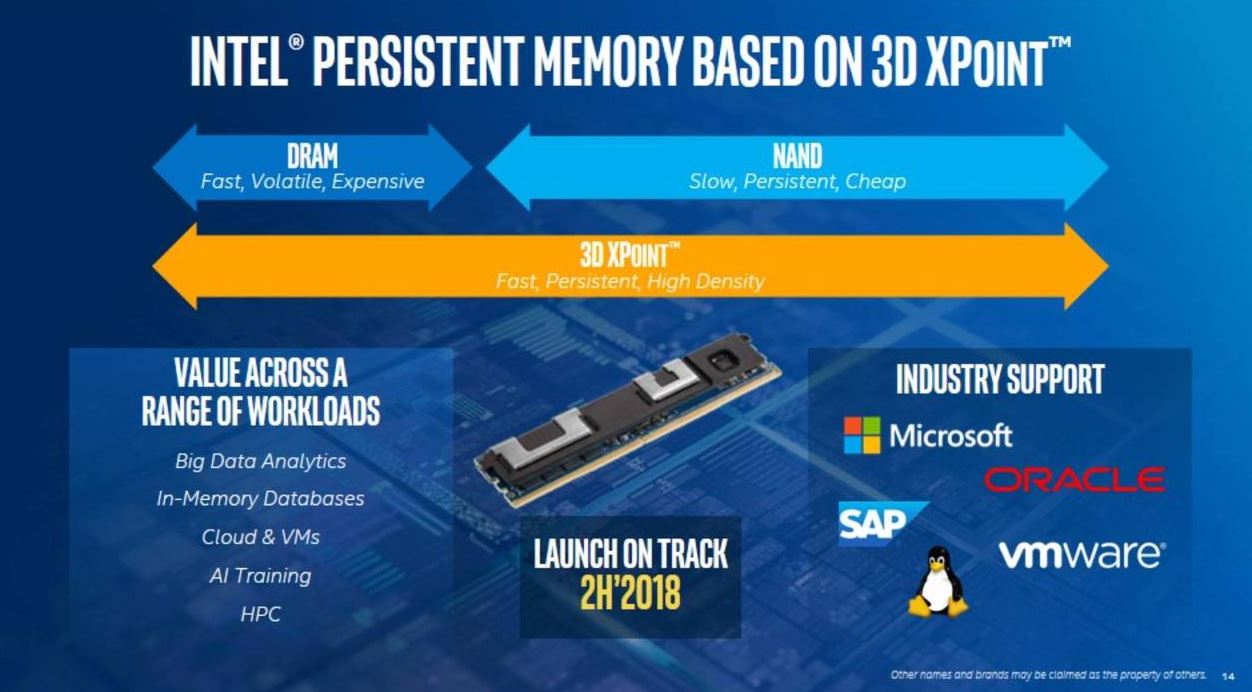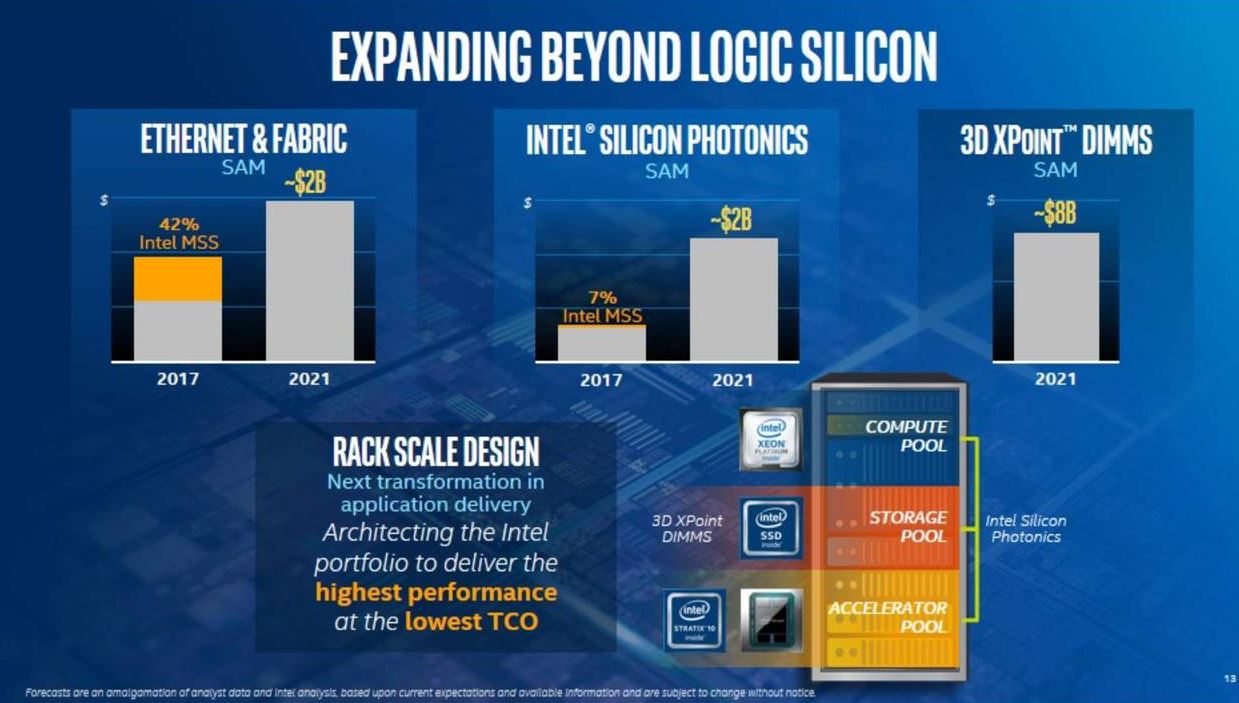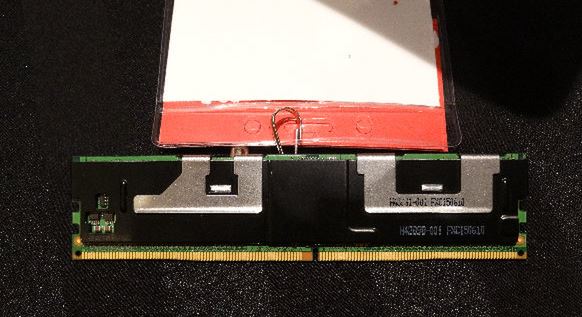Intel Optane DIMMs Coming Second Half Of 2018
Intel finally set a date for Optane DIMMs, saying during a presentation at the USB Global Technology Conference that we'd see them sometime in the second half of 2018, a mere three years after Intel and Micron made the historic 3D XPoint announcement. These DIMMs will function as a memory-mapped device, but with much higher density than DDR4 memory.
This year we've seen the the storage side of 3D XPoint in the form of the DC P4800X Optane SSD for the data center, Optane 3D XPoint Memory for HDD caching, and finally, the Intel Optane SSD 900P, which the first Optane desktop-based bootable SSD. Getting details about Optane DIMMs has been difficult, likely because the execution has been met with a host of challenges. Bringing such increased memory density in a vastly more affordable product is, apparently, no easy task.
The last time we heard Intel talk about it was during the company's Q3 earnings call last year, when company CEO Brian Krzanich mentioned that we'd see 3D Xpoint in the second-generation Purley platform. The first-generation Purley just shipped this past July. At the time of Krzanich's statement, we speculated that the delay could indicate integration difficulties.
Indeed, during discussions at Intel's IDF the prior year, company executives noted that the memory-mapped devices would be mechanically and electrically DDR4 compatible, but that they would require a new (proprietary) interface. The company confirmed at the time that 3D XPoint would not be JEDEC-compliant, at least in the shorter term.
As the slide above outlines, 3D XPoint DIMMs have far-reaching applications that play to Intel's other strategic initiatives, such as its Rack Scale Architecture (RSA). Intel has also been discussing its development of exascale supercomputing platforms, which would be a great fit for 3D XPoint DIMMs. It's easy to assume that we will eventually see 3D XPoint packages tied together into heterogeneous packages with Intel's EMIB technology. Because Intel is using a proprietary memory interconnect for its 3D XPoint DIMMs, this would likely be a good proving ground for using the same techniques with EMIB-attached packages.
Back at Storage Visions in early 2016, we got our first glimpse of an Optane DIMM package, but in the NVDIMM format, plugged into a DDR4 interface, with a capacity of 512GB per NVDIMM, for a maximum of 6TB of addressable capacity with dual-socket servers. This employed an on-board FPGA to manage the underlying 3D XPoint media.
However, since then, we haven't heard about or seen this implementation, feeding rumors that endurance was an issue for the material in heavy-use memory applications. There are also questions about encryption, given that physical-based security attacks will be easier with memory that's persistent.
Get Tom's Hardware's best news and in-depth reviews, straight to your inbox.
We may finally hear a bit more about this at CES in January, with specific details finally coming to light. In this single slide (at the top of the article), you can see Intel call out support from the likes of Oracle, SAP, Microsoft, and VMWare, and touting the benefits accrued to workloads like in-memory databases, but also for things like AI training.
MORE: 3D Xpoint: A Guide To The Future Of Storage-Class Memory
-
bit_user Reply
You mean embedded in-package with CPUs? Maybe for mobile, but 3D XPoint is still much slower than DRAM. So, they might as well keep it outside the package, where you can fill up the DIMM slots with a lot more of it.20379114 said:It's easy to assume that we will eventually see 3D XPoint packages tied together into heterogeneous packages with Intel's EMIB technology
What I'm excited to see coming to an EMIB near you is HBM2. That would be very complementary with 3D XPoint DIMMs. Perhaps this is what Intel is planning with the SoC that will embed the AMD GPU, since NV memory is also great for mobile. -
alan.campbell99 Hmm, I seem to recall with EPYC that AMD was bringing in memory encryption in light of persistent memory. Where is Intel on this and what happens if someone pinches these out of a server?Reply -
bit_user Reply
I thought both had memory encryption for a long time, in order to protect copyright content. Maybe there's some variation that's more suitable for persistent memory.20379373 said:Hmm, I seem to recall with EPYC that AMD was bringing in memory encryption in light of persistent memory. Where is Intel on this and what happens if someone pinches these out of a server? -
photonboy ALan.. I have no doubt that server usage would mean encrypted data. That would be an incredibly major thing to overlook... a very simple way is to have a chip scramble the data into and out of the system memory similar to how your wireless keyboard works.Reply -
samopa I think it would be great if they EMIB DRAM chip with Optane Chip, and put them in DIMM Module, for example 8 GB RAM + 512 GB Optane in one module.Reply
So we can populate our rig with, say there are 4 slot DIMM available, 4 module and get 32 GB of RAM + 2 TB of persistent Storage. No need for NVMe anymore.
Never need to turn off, only sleep or hibernate. -
Druidsmark I've been using Ublock Origin for a very long time now blocks well over 90% of the ads on websites. Yes I know most websites don't like it but I would never click on the advertisements any way as I have no interest in what they offer so tough luck websites, I prefer to read on clean sites not dirtied up with unwanted advertisements.Reply -
uklio Reply20380866 said:I've been using Ublock Origin for a very long time now blocks well over 90% of the ads on websites. Yes I know most websites don't like it but I would never click on the advertisements any way as I have no interest in what they offer so tough luck websites, I prefer to read on clean sites not dirtied up with unwanted advertisements.
If websites have an unobtrusive ad policy that doesn't frustrate my experience with using them, I'll disable the adblocker as i know it is a stream of revenue for them. But if they don't bother and just see the money before the reader, they won't be getting that revenue from my visit! And I have to say the autoplay videos that Toms has on every page are some of the worst examples of not bothering I've seen on the internet.



